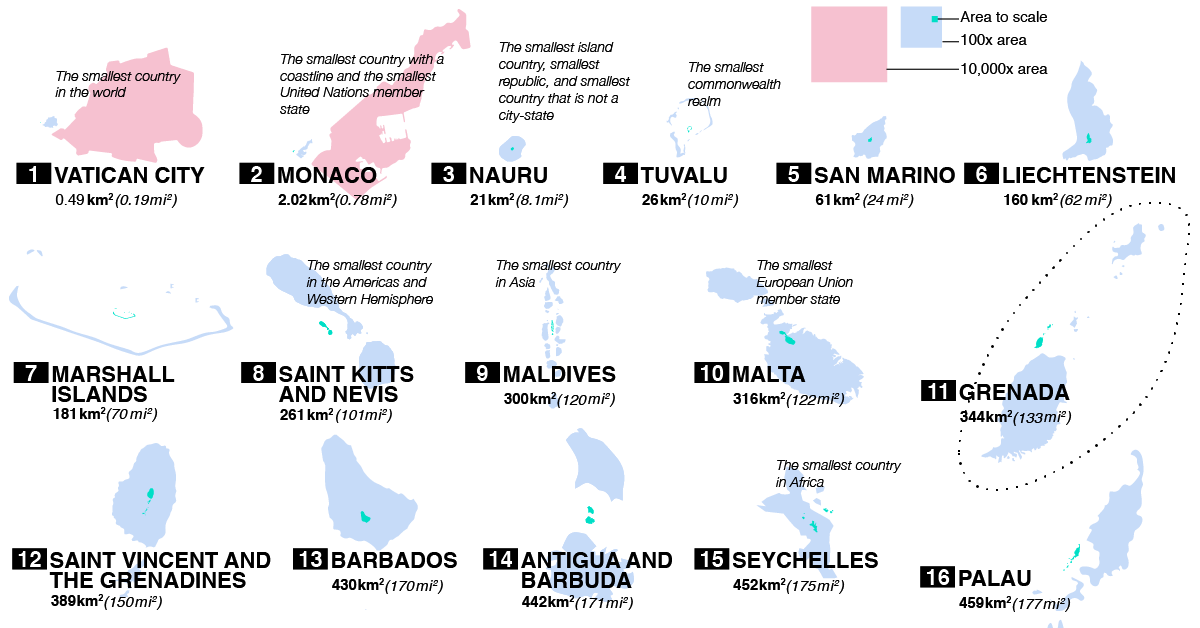Visualized: The World’s 100 Smallest Countries
Mục Lục
The World’s 100 Smallest Countries
National borders may be mere human constructs, but they are powerful ones.
Russia, Canada, the U.S., and so on—it’s easy to focus on the countries with the largest landmasses and seemingly endless borders. Their sheer size makes them hard to ignore, and their natural resources are often vast.
But with the above graphic from TitleMax, we can focus on the power of small.
From economic might to religious influence, many of the smallest countries in the world are surprisingly powerful. Let’s take a closer look at the world’s 100 smallest countries and their spheres of influence.
RankCountrySize (mi²)
1Vatican City0.19
2Monaco0.78
3Nauru8.1
4Tuvalu10
5San Marino24
6Liechtenstein62
7Marshall Islands70
8Saint Kitts and Nevis101
9Maldives120
10Malta122
11Grenada133
12Saint Vincent and the Grenadines150
13Barbados170
14Antigua and Barbuda171
15Seychelles175
16Palau177
17Andorra181
18Saint Lucia238
19Federated States of Micronesia271
20Singapore280
21Tonga288
22Dominica290
23Bahrain300
24Kiribati313
25São Tomé and Príncipe372
26Comoros719
27Mauritius790
28Luxembourg998
29Samoa1,097
30Cape Verde1,557
31Trinidad and Tobago1,980
32Brunei2,226
33Cyprus3,572
34Lebanon4,036
35Jamaica4,244
36The Gambia4,361
37Qatar4,473
38Vanuatu4,706
39Montenegro5,333
40The Bahamas5,383
41imor-Leste5,760
42Eswatini6,704
43Kuwait6,880
44Fiji7,055
45Slovenia7,827
46Israel8,020
47El Salvador8,124
48Belize8,867
49Djibouti9,000
50North Macedonia9,928
51Rwanda10,169
52Haiti10,710
53Burundi10,747
54Equatorial Guinea10,831
55Albania11,100
56Solomon Islands11,157
57Armenia11,484
58Lesotho11,720
59Belgium11,787
60Moldova13,068
61Guinea-Bissau13,948
62Bhutan14,824
63Switzerland15,940
64Netherlands16,160
65Denmark16,639
66Estonia17,462
67Dominican Republic18,792
68Slovakia18,933
69Costa Rica19,700
70Bosnia and Herzegovina19,772
71Croatia21,851
72Togo21,925
73Latvia24,926
74Lithuania25,200
75Sri Lanka25,330
76Georgia26,900
77Ireland27,133
78Sierra Leone27,700
79Panama29,119
80Czech Republic30,450
81United Arab Emirates32,300
82Austria32,383
83Azerbaijan33,400
84Serbia34,116
85Jordan34,495
86Portugal35,560
87Hungary35,918
88South Korea38,690
89Iceland40,000
90Guatemala42,042
91Cuba42,426
92Bulgaria42,858
93Liberia43,000
94Honduras43,433
95Benin44,310
96Eritrea45,400
97Malawi45,747
98North Korea46,540
99Nicaragua50,337
100Greece50,949
Although several of the national borders shown above may be contested, the graphic gives us a clear overview of the globe’s smallest nations.
The Power of Small
Small size doesn’t mean less power. In many cases, it’s the contrary.
The Vatican—the smallest country on Earth at 0.19 square miles—is renowned for its leader and main inhabitant, the Pope. As leader of the Catholic Church, the pontiff and his papal staff make up a sizable part of the country’s tiny population of 825. Most of the Church’s 219 Cardinals, its leading dignitaries, live in their respective dioceses.
With more than 1.2 billion Roman Catholics in the world, the Vatican’s sphere of influence is of course far larger than its small physical size. Although the walls of the Vatican are situated inside the city of Rome, Italy, its centuries-old influence spans continents.
Nearly 40% of Roman Catholics live in the Americas, while the fastest-growing Catholic population can be found in Africa—home to more than 17% of the world’s Catholics.
Purchasing Power
Where the Vatican’s power lies in religion, plenty of spending power is held by the tiny country of Monaco, the second smallest country on Earth.
Situated along the French Riviera, Monaco is surrounded entirely by France—but it also sits fewer than 10 miles from the Italian border.
At 0.78 square miles, Monaco could be compared to the size of a large farm in the U.S. Midwest. Despite its small size, Monaco has a GDP of nearly US$7.2 billion, and boasts over 12,000 millionaires living within one square mile.
Along with Luxembourg and Liechtenstein—both of which are included in the smallest countries list—Monaco is one of the only countries globally with a GDP per capita higher than $100,000.
Switzerland and the Netherlands, both found in this graphic at ranks 63 and 64, also hold large shares of the global economy given their size. These two nations rank 20th and 17th in the world in economic output, respectively.
Similarly, Singapore is the 20th smallest country on the planet, but it ranks in the top 10 in terms of GDP per capita ($65,233) and sits in 34th place globally in terms of nominal GDP.
Perspective is Everything
To give us a better idea of just how small the tiniest countries are, let’s take a look at some simple size comparisons:
- Monaco could fit inside New York City’s Central Park, with room to spare
- Brunei is roughly the same size as Delaware
- Nicaragua, the largest country in Central America, is similar in size to the state of Mississippi
- Nauru is the smallest island nation, and smaller than Rhode Island
- North Korea is roughly the size of Pennsylvania
“Small,” of course, is a qualitative factor. It depends on your vantage point.
As of September 2020, there are 195 countries on Earth. Although this graphic shows the smallest countries in the world, it is worth noting that a list of the world’s 100 largest countries would also include some of the same countries on this list, including North Korea, Nicaragua, and Greece.
Is It A Small World Afterall?
Viewed from space, there are no borders on our tiny blue dot. But from ground level, we know how much power national borders hold.
Although globalization may make our world feel smaller, our nations significantly impact our lives, societally and economically.
And, as this chart shows, power comes in all sizes.
















![Toni Kroos là ai? [ sự thật về tiểu sử đầy đủ Toni Kroos ]](https://evbn.org/wp-content/uploads/New-Project-6635-1671934592.jpg)


